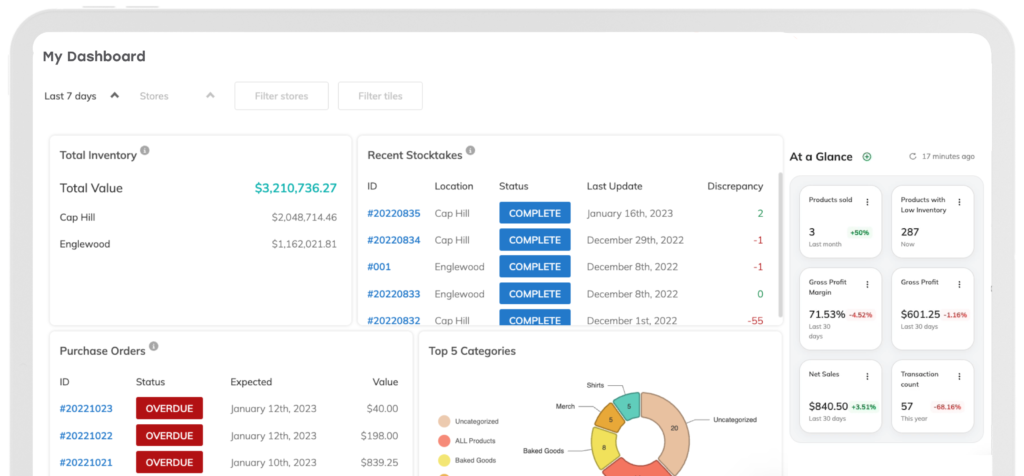
Personal Branding For Entrepreneurs: Strategies And Tips For Small Business Owners
Your brand as an entrepreneur and business owner is just as important as the strong visual and verbal identity you create for your shop. Building a personal brand attracts opportunities in ways that a company can’t, lending a relatable human face to the peaks and valleys of running your own company. If your trajectory as a business owner includes shaping yourself as a thought leader, investing in the way you appear to shoppers and the greater community is well worth the effort.
Benefits Of Building Your Personal Brand
Increase visibility
Creating a brand identity for yourself helps people recognize you, no matter where you show up in person or online. Just like your logo across social media, signage, and flyers, a consistent personal brand that pops up everywhere is proof to your target audience that you’re in demand. This attracts even more opportunities and recognition.
That improved visibility pays off for your business as well as your personal ambitions. Take cues from Cassey Ho, the founder of athletics brand Popflex. Over the course of her career, she built a reputation for developing solution-oriented clothing and accessories, turning directly to her audience for ideas. Even with a whole team behind her, she still uses her personal brand to collect product feedback and inform product strategy.
Build credibility
It’s easy to claim you’re an expert, but how do you prove it? Your strong personal brand does the talking for you. When you have a reputation as a trustworthy source of the product or service you sell, it inches shoppers one step closer to making a purchasing decision.
Sharing a consistent message through your mission and brand story helps others build associations between you and the area of expertise that you want to be known for. Over time, people will seek you out for speaking engagements, commentary, and collaborations in those topics.
Let’s look at an outdoor gear shop as an example. The owner uses their platform to share their recent accomplishment of hiking the Pacific Coast Trail, emphasizing how gear from the shop helped them successfully complete the journey. This riveting story attracts attention from others in the outdoor adventure space, and they’re invited to tell their story at a conference. Now they have the chance to attract an even wider audience with their engaging firsthand experience.

Attract new partners
Your brand identity aligns you with the audiences you want to reach and the companies that you want to work with. There are plenty of conferences, publications, and companies looking to partner with folks who align with their brand ethos. That opens the door to new audiences that learn who you are and feel connected with you on a deeper level.
Over time, that translates to more sales, and even game-changing opportunities. To revisit Popflex, Cassey’s passion for functional, viral-worthy athletic clothing and accessories that followers buy again and again secured her two exclusive runs in Target stores.
Build affinity among customers
Your personal brand helps people get to know you better. That influence carries over into your business, where folks who feel connected to you are willing to take the next step to make a purchase.
Consider a woman-owned beauty business that’s been in operation for over a decade. The owner has invested years into building an online following. Her relatable content and insightful tips tell her audience that her business will deliver products truly made for them. The owner’s personal reputation as an expert drives sales, opening the door for opportunities to partner with big box retailers, expanding their reach even further.

Components Of A Personal Brand
A personal brand encompasses all the things that contribute to the reputation you’re creating as a leader. It guides how you market yourself to the business community and the strategy that helps your target audience get to know you.
As you develop relationships with organizations you align with, a strong brand is the north star that helps you stay consistent while you grow and reach new heights. It doesn’t matter if you don’t have your business idea nailed down just yet or if you’ve been at it for a decade. Your personal brand is still essential for building authority, connections, and sales.
The main components of a strong personal brand include:
- Your values: Identify and share the beliefs that guide you as a business owner.
- Your purpose: Shape your “why” and share it often.
- Your story: Articulate your journey and how it led you to where you are today.
- Your presentation: The way you talk, act, and dress all help people remember you.
How personal branding differs from your business’s branding
Your company’s brand and your small business owner brand are fundamentally different, but they certainly influence one another.
At their core, each brand serves a different purpose. One promotes the products and services you sell, and one markets who you are as a human being. Remember, your business is only one component of the many facets that make up who you are as a person. At the same time, your professional and personal goals are very much part of building a personal brand that attracts more customers who believe in what you stand for.
Power Up
Dive into our expert blog for practical tools and inspiration to grow your business brand.
What It Takes To Build A Strong Personal Brand
1. Establish your mission statement and goals
For a successful personal branding strategy, you need to know why you’re doing this in the first place. Whether you want to be a known consignment shop expert, a champion for Black-owned small businesses, or a leader in your local chamber of commerce, your goals are the destination, and the mission guides the path to obtaining those goals.
Start by answering some fundamental questions. What do you do, why do you do it, and why do you care? The answers will shape the direction you’re headed. Remember, there’s no single “right” mission or goal. What matters is that you select a mission that you care about and you stick with the plan to meet those goals.

2. Know your target audience
The narrative you create needs to appeal to the folks you want to speak to the most. Who do you want to know your name, and why do you want them to know it? That’s your target audience. With your audience defined, everything else about your messaging and marketing methods falls into place.
Your target audience isn’t limited to just a single group, but it should be clearly defined and relatively limited in scope. For example, women-owned vape shops in California represent an overlap of three distinct audiences, but it’s well-defined.
3. Define your narrative
Storytelling is mission-critical to the success of your personal brand. A powerful narrative articulates your mission in a way that deeply resonates with the people you most want to reach. It also helps people better understand why your thought leadership voice is one worth listening to.
Part of your narrative is your unique value proposition, or UVP. What are your perspectives that earn followers and help you stand apart from the crowd? As you develop your narrative, think about how your unique insight shapes your views and intertwine elements of your narrative into your UVP.
To define your narrative, think back on the pivotal moments that made you who you are today. How did they encourage you to think differently or make a big change in your life? Large and small moments alike are fair game; you don’t have to have an earth-shattering, life-changing story to have a strong personal brand.
Feeling stuck? Start here:
- Consider major career moments, such as quitting a high-paying job or getting fired.
- Think about life changes, like moving cross-country or starting a family.
- Tell the story of the moment you decided to become an entrepreneur.
4. Find your brand voice and visual identity
Just like your shop’s logo, colors, and fonts, the way you talk about yourself and your perspective has a cadence that people use to recognize you.
Think about what it means to sound like you and what that means for your brand. Are you a realist about business challenges, or do you see the glass as half-full? Does it align with your narrative to describe customers as “clients,” “shoppers,” or “partners?” Do you wear bright red glasses everywhere you go? These little details contribute to the nuances of a strong personal brand and how people come to recognize and remember you.
5. Create a brand guide for consistency
A style guide for your own messaging functions similarly to the one you create for your business. It spells out how you look, sound, and feel. It helps you stay consistent across additional platforms in print and online. Refer back to it if you’re ever feeling stuck about what to say or how to say it.
The guide is also important for others who promote you. Share it with promoters showcasing your next conference talk or a podcast host creating a social media graphic for you to advertise your episode. And if you need help managing your marketing, hand off the style guide to someone who can help you without missing a beat.
6. Craft a content plan
With a defined target audience and polished messaging, it’s time to start getting your message out there.
Content takes many forms when you’re building your personal brand. Some of the major categories include:
- Speaking engagements
- Hosting your own YouTube channel
- Posting on social media platforms
- Writing a popular email newsletter
- Pitching yourself to the media
Focus on the platforms where your audience spends a lot of time. For many business owners, LinkedIn is a natural place to start. TikTok, YouTube, and Facebook groups are also great options for sharing your point of view with the people you want to hear from you. Longer-form newsletter platforms like Substack give you the freedom to go more in depth.
For best results, create a simple website about yourself. Use it as a central place to share information with potential partners, send your bio to reporters, and showcase the media that interviews you. It’s also incredibly useful for collecting email addresses from visitors, as a robust email list is extremely valuable for self-promotion.

7. Connect with other entrepreneurs
Cross-promotional opportunities are abundant within the entrepreneur community. You’ll find many mission-aligned companies and entrepreneurs who want you in their orbit and vice versa. Whether joining a cohort of founders in your town, a national consortium of gift shop owners, or a group of fellow AAPI entrepreneurs, these communities are where you find the collaborations and connections that take your personal brand to the next level.
Power Up
Ready to boost your business with meaningful partnerships? Dive into the full guide.
8. Measure your progress and make adjustments
Expect some trial and error as you build your personal brand. Some things you try will be runaway successes, while others will turn out to be duds. That’s a normal part of this process. Embrace it!
To know what’s working best, monitor which activities bring you closer to your goals. Ask the podcast host how many times your episode was downloaded. See which of your pop-ups or speaking engagements drew the biggest crowds. Look into how many leads came from the interview you conducted in the local newspaper. Double down on what works and reconsider those efforts that weren’t as successful as you hoped.
Two Personal Branding Examples That Shaped Business Success
Sagebrush: Building personal connection with customers
When Sagebrush Coffee started as an online shop, coffee lovers didn’t get daily face to face interactions like they do with a barista. Long before opening a brick-and-mortar cafe, they were able to build a solid foundation with their target audience. Sagebrush owner and founder Matt Kellso made deliberate strides to break the digital divide by sharing more about his personal life, not just information about the beans on his menu.
“When I’m an online business, it could be that [customers] don’t know me… and in the online world, it seems like [we’re] just another website,” Kellso shared. “That’s why we’ve tried to be as transparent as a family and as a business as we can in front of [our customers].

This finding led to the development of “Just What We’re Drinking,” a newsletter where Matt and other employees of the family-owned business share what’s in their mugs.
“It’s just a way to humanize the business and make it feel like a community, not just a transaction,” Kellso said.
The Power Up Podcast: Sagebrush Coffee
Discover how, and why, Matt has expanded his business Sagebrush Coffee over the years and the role marketing has played across various channels.
Kushae: Creating a community by women, for women
Kushae CEO Kimba Williams established her expertise in the feminine hygiene space along with the help of co-founder and OB/GYN Dr. Barb. A huge part of Kushae’s success is due to the wealth of professional knowledge its founders bring to the table. Since the beginning, Kushae has prioritized real-world concerns and feedback in developing its products. Kimba explains how Dr. Barb’s experience with patients directly influenced their business’s evolution.

“Dr. Barb is a certified OB/GYN with 20-plus years of experience,” Kimba explained. “So people actually pay her to talk about problems, and so market development was much easier for us… Dr. Barb and I would meet every week, and she’d be like, “Here’s what patients are complaining about now.” And so that was much easier, and her patients got a bird’s-eye view of the new products.”
Today, all of Kushae’s growing audience gets to share in that valuable knowledge, along with their high-quality products. From Kimba’s relatable social media posts to “The Tea for Your V” YouTube series on hot topics, customers have multiple ways to connect with the personalities behind Kushae.
The Power Up Podcast: Kushae
Women’s health is a difficult topic to approach, but not for Kushae. Learn how Kimba Williams and Dr. Barb OB/GYN have made it approachable, fun, and even sexy.
A Strong Personal Brand Is Key To Small Business Success
Shoppers are getting savvier by the day. They want to support businesses and individuals with whom they share values. When you step out from behind the curtain, you open opportunities for deeper connections with soon-to-be loyal customers by putting a human face to a faceless company brand. As you develop your unique point of view and share it with the world, you establish yourself as a go-to trusted resource that attracts aligned customers and partners.
It takes time to create that reputation. Start now, and you’ll enjoy the benefits for years to come.
The Newsletter For Small Businesses
Weekly expert insights, industry trends, and inspiring stories designed to help you run your business with confidence.
The Only Inventory System That Actually Helps You Run A Healthy Business
Thousands of customers all over the world use Thrive Inventory to run a healthy business.
Thrive Inventory gives you control over all your inventory, sales channels, and metrics, allowing you to make the right decisions at the right time.
Keep Reading

The Newsletter For Small Businesses
Weekly expert insights, industry trends, and inspiring stories designed to help you run your business with confidence.
Try Thrive Inventory For Free
Add Thrive to your business and maximize your potential. With powerful and easy-to-use products,
it’s time to take control of your business and see what you can do with Thrive.




